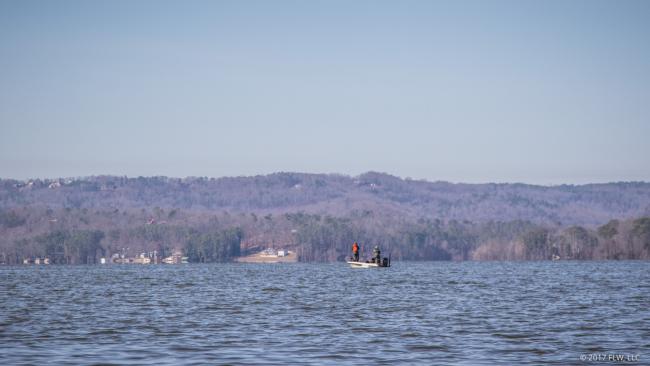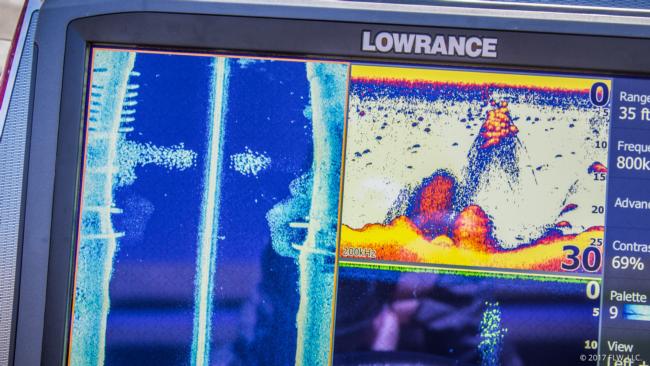Getting to Know Guntersville
Check out the playing field for the 2017 FLW Tour opener

Lake Guntersville might be the most famous bass lake in the country and has long been one of the most popular. Though Guntersville might not be exactly at her peak right now, it’s still an exceptional lake, boasting some truly spectacular bass and a pile of fishing history.
When the 2017 FLW Tour opens on Guntersville on Thursday, each of the 165 pros on Tour this year will be giving it all he’s got to add his name to the long list of epic Guntersville triumphs.
Built on the Tennessee River, Guntersville sits between Lake Nickajack at the upper end and Wheeler Lake at the lower end. Both of the neighbor lakes have good fishing, but neither has been able to hold a candle to Guntersville in recent memory.
Though Guntersville doesn’t fluctuate as much as fellow Tennessee River reservoir Kentucky Lake or a mountain reservoir, it does have a lot of current. Through practice, about 56,000 CFS have churned through or poured over the dam most days.
The point at the entrance to Honeycomb Creek shows a good example of the bluffs that line the river channel on the lower end of the lake. Inside, Honeycomb is one of many productive creeks on the lake and is known for being one of the clearest.
Alred’s, or Lush Branch, is a big bay studded with little drops, flats and islands. It’s right near the town of Guntersville and is the last really big area of relatively shallow water before the lake deepens and steepens down near the dam. It’s daunting to pick through so many different little points and edges, but the area is known for plenty of grass and bass. Countless tournaments have been won in the area, but it’s a major challenge to break down in a timely manner.
The shoreline in and around the town of Guntersville is pretty industrialized. From riprap to grain mills to barge tie-ups, there’s a lot of evidence that the Tennessee River is a major mover of goods.
The town of Guntersville mostly rests on a point in between two major creeks on the lower end of the lake. On one side is Browns Creek, which is an excellent fishing area. On the other side is Spring Creek, which is crossed by two causeways, one of which held the winning fish for Randy Howell during the 2014 Bassmaster Classic.
Probably the most important feature of Guntersville is the grass. There are all kinds of grass in the lake, but the three most important and prevalent are hydrilla, eelgrass and milfoil. You can find hydrilla and milfoil all over the lake, but the eelgrass is largely confined to the upper end. That’s where it first appeared, and where it has taken hold the strongest. Eelgrass also tends to grow in current more than milfoil or hydrilla. It thrives along the edges of the main and secondary channels.
Shallower, emergent vegetation can also be key on Guntersville. Mark Daniels Jr. targeted dead pad stems for a top 10 in a Costa FLW Series event in March 2015, and gator grass can hold some true giants at the right time. It’s not likely that pads or gator grass will really play in the Tour opener, but it’s not entirely out of the question. Both are certainly good cover for bass and plentiful enough.
Like any Tennessee River lake, there’s a strong offshore bite nearly year round. Because of the grass, a lot of fishing revolves around where vegetation grows offshore, but that’s not the only deal going. There are plenty of ledges, shell beds, rock piles and stump fields to command the attention of bass and anglers.
Located on the east side of Guntersville, north of the Lake Guntersville State Park, South Sauty Creek is a mainstay for sure. Countless tournaments have been won there, and Jay Kendrick spent a pile of time on the bridge at South Sauty when he won the Costa FLW Series event on Guntersville in 2015.
Slightly to the north and on the west side of the lake, North Sauty and the bridge at the mouth of it are equally famous. It’s a sure bet that both creeks will play a role for someone this week.
Just above North Sauty (and somewhat attached to it), Goose Pond has one of the most popular and best-located ramps on the lake. It’s also got some great fishing in the creek behind the island. The creek at Goose Pond is somewhat emblematic of the other creeks that dot the northern, more riverine section of Guntersville. It’s shallower and a little smaller than Spring Creek, but it still has very good fishing. There are offshore roadbeds and the like in the northern creeks, but the main focus is the grass.
In addition to grass and offshore structure, there is plenty of other good-looking stuff present. There are big laydown pines, laydown hardwoods and tons of gorgeous rocky banks that look like jerkbait heaven. There are also piles of docks that range from deep to shallow, both in pockets and right along the main lake.
In addition to all the cover and structure in Guntersville, the lake is loaded with bait. From threadfin and gizzard shad to skipjack herring and crappie, it’s hard for a bass to go hungry. There’s always tons of bait around the bridges (which is part of why they are so good), but it’s no surprise to see a cloud of shad over any random drop in the lake.
Up the lake from Goose Pond, the B.B. Comer Bridge crosses the lake. It’s about there that the lake really begins to narrow down into a main channel and a secondary channel and the creeks get smaller and turn into something closer to big backwaters. There’s more eelgrass around B.B. Comer than anywhere else on the lake, and it’s sure to get some pressure from anglers hoping to find some grass-dwelling bass.
Even though it’s pretty far north on Guntersville, the B.B. Comer Bridge is not nearly the end. There is plenty of fishable water for another 20-plus miles.


















